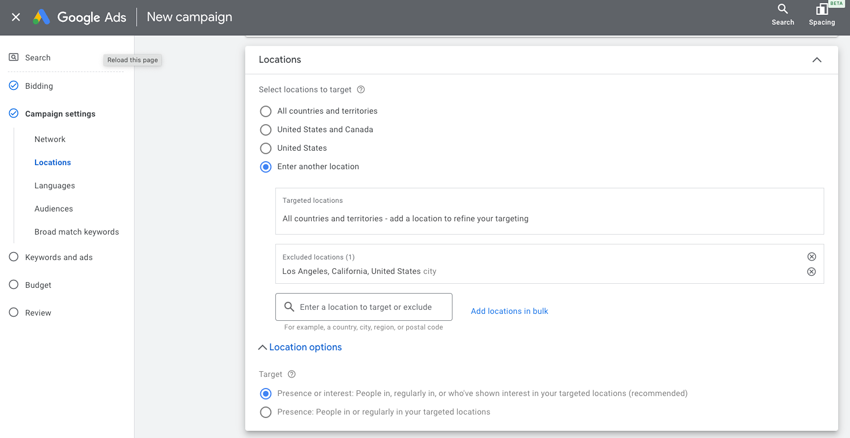Share via:

-
Save
There are two essential benefits to using Google Ads location targeting in SEM marketing campaigns: precision targeting and budget-saving. Unless the targeted demographic is truly worldwide, focusing the advertising dollars on the most marketable and lucrative customer locations makes more sense.
What is Google Ads Location Targeting
Location targeting ads are location-specific SEM marketing campaigns shown to an audience in a specific geographic area. Location targeting ads are set up to target multiple demographic locations with different ad content to maximize ROI (Return on Investment).
Example of Google Ads Location Targeting
For example, let’s say you are hosting a promotional event for customers in New York City area. With location targeting ads, you can set up the ad to target audience with a physical location in New York City only. Both Google Ads and Microsoft Ads allow the inclusion, exclusion, or setting of a specific geographic location radius.
Why Businesses Need Google Ads Location Targeting
Location targeting ads help businesses focus their marketing efforts on the local market. When creating a new campaign within Google Ads or Microsoft Ads, there is an option to choose “all countries,” select a few territories, or choose “United States only.” The settings within location targeting ads provide the flexibility to target ads more aggressively in the active markets and dial down in the less active regions.
Top 6 SEM Marketing Strategies on How to Optimize Google Ads Location Targeting
Strategy #1: Add Location-Specific Keywords in Google Ads Location Targeting
If an ad is specifically designed to market to selected states within the US, it is a good idea to include the location in the ad content. Doing so improves click-through rate and eliminates irrelevant traffic from unqualified locations.
Examples of Using Location-Specific Keywords in Google Ads Location Targeting
- Buy a new dining table set today for half off. Visit our New York City store.
- Our dining table sets are handmade in New York and have a 10-year warranty.
Try the Free Google Ads Generator for Ad Headlines
- 100% Free
- No Account Required
- Available 24/7
Strategy #2: Define Location Radius in Google Ads Location Targeting
To set the radius of ad targeting within a specific distance from a defined location, use the Radius Targeting option in Google Ads to select a range of distance from a geographical location. Hone in and micromanage ad deliveries to target visitors who fit into your ideal customer profile (ICP) from high-converting geographic areas.
How to Define Location Radius in Google Ads Location Targeting
- Log into your Google Ads account, and go to the “Campaigns” tab.
- Select the campaign you are working on.
- Click on the “Settings” tab.
- From the “Locations” row, click on “Edit.”
- Click “Advanced Search.”
- Click on the “Radius Targeting” link at the top, where the menu is located.
- Enter an address or the coordinates of a location(s) into the search box.
- Input the number of miles/kilometers for the radius from the location of your choice, and hit the search button.
- Click “Add,” and your selected locations will turn blue on the Google Ads map.
- Click “Done” to complete.

-
Save
Try the Free Google Ads Generator for Ad Descriptions
- 100% Free
- No Account Required
- Available 24/7
Strategy #3: Exclude Negative Keywords in Google Ads Location Targeting
Once in a while, you will get search terms that do not match the location predefined in the targeted ads. When this happens, ad campaign costs can increase because the ad was shown to the wrong audience, resulting in wasted clicks.
Use Google Ads Search Terms Report to Eliminate Negative Keywords in Ad Campaigns
Run a “Search Terms Report” within Google Ads to track keywords that generate ineffective leads outside the defined locations. Include these terms as negative keywords and omit them from the ad campaign.
Find a list of search terms that trigger the ad campaigns within the Search Terms Report. Comb through the keywords carefully and look for words or phrases that do not match your specified location criteria. Add these irrelevant terms to the negative keyword list to stop the ads from targeting the wrong audience.
How to Run a Search Terms Report
- Click on an active campaign.
- Click the “Keywords” tab.
- Click on the “Search Terms” box.

-
Save
- Log into your Google Ads account, and go to the “Campaigns” tab.
- Select the campaign you are working on.
- Go to “Settings.”
- Scroll to the “Locations” row and click “Edit.”
- Select “Advanced Search.”
- Within the search box, enter the country, state, or city you wish to exclude from the ad campaign.
- Choose “Exclude Link” (next to “Add Link”). The excluded locations will turn red on the Google Ads map.
- Click “Done” to complete
Learn more about SEM ad campaign cost control strategies.
Strategy #4: Exclude Low Performing Locations Through Google Ads Location Targeting
Avoid wasting marketing dollars on targeting locations that do not generate leads. Instead, focus on the locations where the ad campaigns make the most impact and conversions.
Example of Why Businesses Should Exclude Low Performing Locations in Google Ads Location Targeting
For example, if you are an e-commerce business, research the target demographics thoroughly based on the average consumer income, buying powers, and demand. Exclude the locations in Google Ads that do not match your ideal consumer profile (ICP).
How to Exclude Low Performing Locations in Google Ads Location Targeting
Strategy #5: Conduct Periodic Market Research to Improve Google Ads Location Targeting Performance
Geographic market trend research is a great start to optimizing location targeting ads. Save marketing campaign costs by allocating the budget to win keywords with the most demand in high-performing geographic locations.
How to do Market Research with Google Trends to Improve Location Targeting Ad Performance
Google Trends is a great tool for researching the locations with the most demand for a product or service. The tool shows a breakdown of keywords searched by country, sub-region (state or province), metro, or city. The best part, Google Trends is free to use.
Example of Market Research with Google Trends
The example below shows the top US states searching for the term “ergonomic chair,” with California yielding the most searches for the keywords.

-
Save
Strategy #6: Adjust Bids According to Location in Google Ads
Burning through the budget on an ad campaign can happen faster than you think. Focus on high-conversion locations frees up marketing budget for campaigns that make a true impact. Set the bids higher in locations with higher performance and lower bids in less active geographic regions. Quality, not the number of clicks, creates conversion.
Take Advantage of SEM Marketing Ad Scheduling
Utilize SEM marketing ad scheduling to target ads more aggressively when visitor traffic peaks. Automatically adjust keyword bids during these peak hours to capture more market shares. Set the schedule to lower bids during off-peak hours to reduce marketing spend. It is a cost-effective way to stretch the marketing budget and precisely target ready-to-buy prospects.
Perfecting Google Ads Location Targeting
Keep testing and monitoring the locations of the ad campaigns to ensure optimal performance. Go one step further by making customized landing pages based on different regions and tailoring content based on specific locations for better visitor engagement.
Learn more about how to create high-converting SEM ad campaigns.
Continue the Learning Journey with Amppfy
Amppfy’s digital marketing resource library is beginner-friendly, and zero technical or marketing experience is required to get started. Learn how to create a practical, actionable, and programmatic digital marketing playbook for any business website, e-commerce store, or content platform. Leverage effective SEO, SEM, and social media strategies to boost brand authority, increase online visibility, and generate quality demand.
Follow us on LinkedIn, Facebook, Instagram, and YouTube to stay updated on the latest marketing news, strategies, and free content.
Get Started with Free Generative AI Marketing Tools
- 100% Free
- No Account Required
- Available 24/7
Share via:





